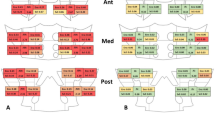Abstract
The purpose of this study is to evaluate the prevalence of pelvic enthesopathy on computed tomography (CT) in patients with DISH compared to matched control group. Pelvic CT examinations of patients with DISH (Resnick criteria) were retrospectively evaluated for the presence of enthesophytes at four entheseal sites bilaterally: ischial tuberosity, pubis, greater trochanter, and anterior superior iliac spine (ASIS). This was compared with age- and gender-matched control group of consecutive patients with <2 flowing osteophytes on CT along the entire spine. Multivariate analysis of variance (ANOVA) was applied to examine the degree of difference between pelvic enthesopathy in DISH patients and controls and to estimate the potential predictive ability of the different findings. Logistic regression analysis was used to estimate the odds ratio of the studied findings. Pelvic CTs of 210 patients (149:61, M:F; average age, 72.3 years) were evaluated: DISH group, 104 patients (74:30, M:F); matched control group, 106 patients (75:31, M:F). Mean total and local enthesopathy scores were significantly higher in the DISH group compared with the control group (total 5.03:1.9; ASIS 1.58:0.55; pubis 0.94:0.36; ischial tuberosity 1.47:0.76; greater trochanter 1.04:0.24; p < 0.001). ASIS and greater trochanter enthesophytes were the most robust contributors that significantly distinguished between patients with DISH and those without DISH. Prominent enthesophytes were more common among DISH patients (DISH:controls, 52:13, p = 0.02). Prominent pelvic enthesophytes detected on CT have a strong discriminating power between DISH and non-DISH patients. Results imply that pelvic enthesopathy may be included in the radiographic criteria for DISH.

Similar content being viewed by others
References
Resnick D, Niwayama G (1976) Radiographic and pathologic features of spinal involvement in diffuse idiopathic skeletal hyperostosis (DISH). Radiology 119:559–568
Utsinger PD, Resnick D, Shapiro R (1976) Diffuse skeletal abnormalities in Forestier disease. Arch Intern Med 136:763–768
Arlet J, Mazieres B (1985) Hyperostotic disease. Rev Med Interne 6:553–564
Julkunen H, Heinonen OP, Knekt P, Maatela J (1975) The epidemiology of hyperostosis of the spine together with its symptoms and related mortality in a general population. Scand J Rheumatol 4:23–27
Beyeler C, Thomann SR, Gerber NJ, Kunze C, Aeberli D (2015) Diffuse idiopathic skeletal hyperostosis (DISH) of the elbow: a controlled radiological study. BMC Musculoskelet Disord 16:119
Littlejohn GO, Urowitz MB (1982) Peripheral enthesopathy in diffuse idiopathic skeletal hyperostosis (DISH): a radiologic study. J Rheumatol 9:568–572
Mader R, Sarzi-Puttini P, Atzeni F et al (2009) Extraspinal manifestations of diffuse idiopathic skeletal hyperostosis. Rheumatology (Oxford) 48:1478–1481
Fahrer H, Barandum R, Gerber NJ, Friederich NF, Burkhardt B, Weisman MH (1989) Pelvic manifestations of diffuse idiopathic skeletal hyperostosis (DISH): are they clinically relevant? Rheumatol Int 8:257–261
Haller J, Resnick D, Miller CW et al (1989) Diffuse idiopathic skeletal hyperostosis: diagnostic significance of radiographic abnormalities of the pelvis. Radiology 172:835–839
Mader R, Novofastovski I, Iervolino S et al (2015) Ultrasonography of peripheral entheses in the diagnosis and understanding of diffuse idiopathic skeletal hyperostosis (DISH). Rheumatol Int 35:493–497
Biswas D, Bible JE, Bohan M, Simpson AK, Whang PG, Grauer JN (2009) Radiation exposure from musculoskeletal computerized tomographic scans. J Bone Joint Surg Am 91:1882–1889
Mata S, Fortin PR, Fitzcharles MA et al (1997) A controlled study of diffuse idiopathic skeletal hyperostosis. Clinical features and functional status. Medicine (Baltimore) 76:104–117
Utsinger PD (1985) Diffuse idiopathic skeletal hyperostosis. Clin Rheum Dis 11:325–351
Mader R, Verlaan JJ, Buskila D (2013) Diffuse idiopathic skeletal hyperostosis: clinical features and pathogenic mechanisms. Nat Rev Rheumatol 9:741–750
Secundini R, Scheines EJ, Gusis SE, Riopedre AM, Citera G, Maldonado Cocco JA (1997) Clinico-radiological correlation of enthesitis in seronegative spondyloarthropathies (SNSA). Clin Rheumatol 16:129–132
Yaniv G, Bader S, Lidar M et al (2014) The natural course of bridging osteophyte formation in diffuse idiopathic skeletal hyperostosis: retrospective analysis of consecutive CT examinations over 10 years. Rheumatology (Oxford) 53:1951–1957
Mader R, Buskila D, Verlaan JJ et al (2013) Developing new classification criteria for diffuse idiopathic skeletal hyperostosis: back to square one. Rheumatology (Oxford) 52:326–330
Resnick D, Niwayama G (1983) Entheses and enthesopathy. Anatomical, pathological, and radiological correlation. Radiology 146:1–9
Rogers J, Shepstone L, Dieppe P (1997) Bone formers: osteophyte and enthesophyte formation are positively associated. Ann Rheum Dis 56:85–90
Benjamin M, Toumi H, Suzuki D, Redman S, Emery P, McGonagle D (2007) Microdamage and altered vascularity at the enthesis-bone interface provides an anatomic explanation for bone involvement in the HLA-B27-associated spondylarthritides and allied disorders. Arthritis Rheum 56:224–233
Julkunen H, Heinonen OP, Pyorala K (1971) Hyperostosis of the spine in an adult population. Its relation to hyperglycaemia and obesity. Ann Rheum Dis 30:605–612
Author information
Authors and Affiliations
Corresponding author
Ethics declarations
Disclosures
None.
Additional information
Einat Slonimsky and Naama Leibushor contributed equally to this work.
Rights and permissions
About this article
Cite this article
Slonimsky, E., Leibushor, N., Aharoni, D. et al. Pelvic enthesopathy on CT is significantly more prevalent in patients with diffuse idiopathic skeletal hyperostosis (DISH) compared with matched control patients. Clin Rheumatol 35, 1823–1827 (2016). https://doi.org/10.1007/s10067-015-3151-3
Received:
Revised:
Accepted:
Published:
Issue Date:
DOI: https://doi.org/10.1007/s10067-015-3151-3




